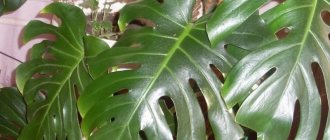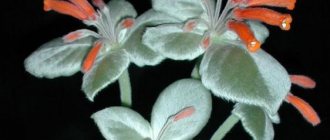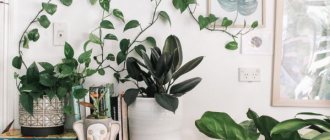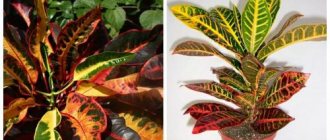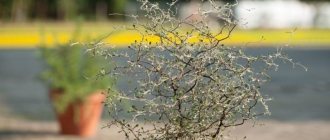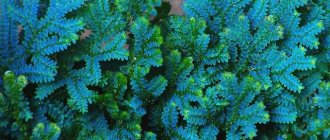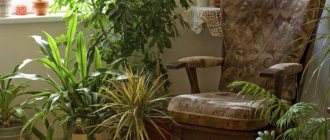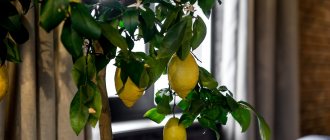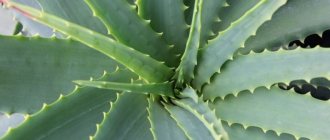Everyone has heard about succulents since school, they can even name several representatives. But few people know that this group includes plants that do not have a common origin. They are grouped together because they grow in similar conditions and they have tissues that store water. This article will look at succulent plants that have taken root in pots on the windowsill and do not require much care, just admiring their beauty.
Succulents and their classification
Succulents (from the Latin succulentus, “succulent”) are plants that have special tissues for storing water. As a rule, they grow in places with arid climates.
Succulent means “juice” in Latin.
Almost all representatives of this plant species came to us from hot countries. Prolonged lack of moisture causes plants to store water in their fleshy stems or leaves. This is where their general classification came from - stem and leaf succulents. We're willing to bet that you've seen some types of succulents on your grandmothers' windowsills, but didn't know their name. Well-known representatives of stem succulents include:
Adenium Dorstenia
Spurge
Pachypodium
Many people wonder, are cacti and succulents the same thing? These are different plants, but most cacti are stem succulents with reduced leaves.
Gymnocalycium Mihanovich Gymnocalycium anisitsi Mammillaria Trichocereus
Note that stem succulents are diverse and unusual in their flowering. The flowers of these representatives are always bright and exotic.
Leaf varieties of succulents have taken root most of all in the apartments of amateur gardeners. They are distinguished by dense thickened leaves. Often the leaves are collected in a rosette. For such plants, this is an additional opportunity to retain moisture.
Popular families
Succulent plants, regardless of species, are divided into many families. However, in horticulture, the main families are recognized, such as:
- Cactus family (Astrophytum, Opuntia, Mammillaria);
- Family of swallowtails (Caralluma, Stapelia, Guernia);
- Asphodel family (Aloe, Gasteria, Haworthia);
- Crassula family (Kalanchoe, Sedum, Crassula);
- Euphorbiaceae family (Poinsettia, Codiaum, Pedilanthus);
- Family Aizoonaceae (Lithops, Conophytum, Fenestraria).
Also read: Exotic Tillandsia: epiphytic and potted species
Useful video
There are a large number of indoor species. Plants differ in shape, color and structure; they are united only by climatic conditions and endurance. They are widely used for medical purposes and are also involved in the production of cosmetic products. Also, do not forget about the ability of this plant to decorate any interior. An indoor succulent flower can live in a house with temperature fluctuations, which does not have a negative impact on its development.
Photos and names of succulents
Here are the most common and well-known types of indoor succulents. To enlarge the image, you need to click on the image once.
Agave Aichrizon Aloe Vera Aloe variegated Gasteria
Graptopetalum Dikkia
Zamioculcas
Kalanchoe Cotyledon
Crassula Russo Lithops Rejuvenated Oscularia Sedum
Pachyphytum Peperomia Portulacaria Sansevieria Synadenium Stapelia Frithia
Haworthia Schlumbergera Echeverea Aeonium Yucca
Leaf succulents
These plants store moisture mainly in their leaves. Therefore, they are thick, covered with a silvery coating, and light in color (dark green leaves are extremely rare).
Aloe
Belongs to the Asphodelaceae family and has more than 500 species. In indoor conditions, the most common representatives are:
Aloe arborescens
Aloe vera
Aloe tiger
Aloe shortifolia
Aloe humilis
It is worth noting that all types of aloe are very desirable inhabitants in rooms where there are children and crowded. These plants release phytoncides into the air, which kill pathogens. They also fit perfectly into any interior.
Gasteria
Belongs to the same family as aloe. It has thick leaves and got its name because of the flowers that resemble the stomach.
Gasteria spotted
Gasteria keeled
Gasteria tiny
Gasteria marbled
Gasteria Armstrong
Haworthia
Representatives of this genus belong to the Asphodelaceae family, and together with Gasteria and Aloe are included in the Aloe tribe. All plants are dwarf, small plants, but very beautiful.
Haworthia striped
Haworthia mosaic
Haworthia limofolia
Haworthia herbaceous
Haworthia terciformes
Haworthia pearl
Rejuvenated
Although it belongs to the Crassulaceae family, this genus is a deciduous succulent. Many beautiful herbaceous plants attract people with their unpretentiousness and vitality. These plants are also called Stone Rose, as the leaves are collected in rosettes similar to roses.
Young dwarf
Marble rejuvenated
Rejuvenated cobwebby
The Russian was rejuvenated
Echeveria or Echeveria
This genus also applies to the Tolstyankovs. The leaves are watery, dense, thick, and can have different colors and shapes. It is a popular indoor flower because it is not picky and flexible in care.
Echeveria agave
Echeveria alba
Echeveria graceful
Echeveria bristles
Sedum or Sedum
These plants belong to the Crassulaceae family. They have fleshy leaves. There are many creeping species, the stems can hang down to a meter in length. Therefore, they are often used as hanging plants. Representatives of sedums reproduce easily, are easy to care for, and grow quickly. Excellent for forming succulent compositions or compositions with cacti.
Morgana sedum
Sedum red-colored
Weinberg's sedum
Sedum Steel
Sedum Burrito
Lithops
These are the so-called living stones. They have adapted to camouflage themselves with them, so it is difficult to see lithops from the first time against the background of stones. The plants have two small, but very thick, leaves. They have no stems. Between the leaves there is a gap through which a shoot with a flower grows. Every year the leaves are renewed. The dormant period is simply very little growth. They do not go into complete hibernation, like cacti.
Lithops is beautiful
Lithops pseudotruncated
Lithops divided
Lithops kegleformes
These are the succulents that can most often be found on the windowsill. These plants are now at the peak of popularity. They are used to make many compositions both indoors and in gardens, flower beds, even hedges.
Succulents: care
Growing plants from the succulent family is not particularly troublesome. But there are plants that either take root or do not take root in the house. So, for some, azalea blooms without special care, while for most gardeners it is a very whimsical plant. The orchid, which is essentially a weed, bursts into color with complete beginners, but with “experienced” florists it constantly dies. A similar story happens with “succulent” representatives of indoor plants. However, there are basic rules for caring for them:
- All succulent flowers need good lighting, so the best place for them is a windowsill. From the end of spring it is advisable to place them on the balcony.
- The temperature from spring to autumn should be moderate. In winter, it is better to store succulent plants in a cool place - ideally at 13 -15 ° C.
- The air in the room should be moist and fresh. In summer, ventilation is necessary. There is no need to spray the leaves!
- Watering is moderate. In warm weather once a week, in cold weather - once a month.
- Water for irrigation should be taken at room temperature, as for most other indoor plants.
- Indoor succulents do not like peat. They need to be planted in a mixture consisting of leaf, turf soil and coarse sand in equal proportions. Good soil drainage is one of the prerequisites that must always be observed. The soil should remain moderately moist. Fertilizing for cacti and succulents is carried out in the spring once a month. There is no need to feed them in winter.
Home succulents do not need annual replanting. If the succulent is full of energy, grows, blooms and does not get sick, then you should not disturb it with transplants. If the plant has stopped growing, the skin has lost its elasticity or its usual color, then it is necessary to urgently take measures to transplant it into another soil. Replant it in dry soil mixture and water it after a few days.
The most persistent and picky ampelous indoor plants
If you want to decorate your house or apartment, you can purchase beautiful and unpretentious hanging indoor flowers. Plants take root not only indoors, but also outdoors: on the terrace, on the balcony, in the gazebo. To prevent flowers from losing their aesthetic qualities, they must be periodically pinched and dried leaves removed.
In total, there are 3 types of hanging plants:
- succulents;
- blooming;
- decorative deciduous.
Most of these species were brought from hot countries with dry climates, so the place for them must be carefully chosen. In order for plants to develop better, it is recommended to sometimes turn them towards the light.
Important! When the buds open, the plant only needs to be watered. There is no need to carry out other care procedures, otherwise the flower may stop developing.
Among the most persistent ampelous indoor plants are the following.
- Hoya carnosa. The fleshy leaves of this flower accumulate enough liquid, so Hoya carnosa can easily do without water for 2-3 months. When providing normal lighting, watering and fertilizing, beautiful umbrella flowers appear on the plant.
- Chlorophytum. A simple and unpretentious flower survives even with minimal amounts of light and water. But in order for chlorophytum to bloom, it needs to be looked after more carefully: water it every 12 days, feed it 2 times a month, and spray it with water. The last procedure is best done regularly.
- Fuchsia ampelous. At the edges of the stems there are bright single-color and sometimes two-color flowers that form real cascades. Flowering lasts about 6-7 months, so this plant is popular. In addition, ampelous fuchsia does not require careful care: it grows well both in partial shade and on an open balcony.
- Tradescantia. The evergreen plant pleases its owners with beautiful flowers that have different shapes: lanceolate, oval, elliptical. Thick leaves grow alternately and are distinguished by bright shades: purple, pink, emerald. Tradescantia also does not require special care; it does well on eastern and southern windows.
Planting and propagating succulents
Cacti and succulents have two methods of reproduction: seed and vegetative . The seed method is the most difficult. It is necessary to maintain the optimal temperature for seed germination, approximately 25 °C. If you use succulent seeds for propagation, you should choose well-ripened, fresh and proven material. Therefore, most plant growers resort to the proven method of propagation by stem cuttings and leaves.
After separation from the mother plant, the planting material of almost all succulent plants must be air-dried (3-14 days depending on the size of the cutting) so that the damaged tissues dry out. Otherwise, the cutting will simply rot. The temperature at night and during the day should differ by 10-15 degrees. Therefore, the best time for reproduction is considered to be late spring or early autumn.
The planting container should be almost flat. As a substrate, use ordinary forest soil mixed with 1/4 river sand and 1/5 charcoal. The cuttings are laid out on the surface of a damp, loose substrate, without sticking or burying their base. The dishes with leaves are placed in diffused light. Leaves usually take root within 2-3 weeks. After this, within 1-2 months they lay small rosettes, which begin to slowly develop. The primary roots of a rosette-leaf pair belong to the leaf. After the rosette forms its own roots, the mother leaf dies after some time.
Popular home succulents
Echeveria
In nature, there are about 170 species of this plant. Echeveria hybrids are also grown at home - these are Pachiveria and Graptoveria. It has smooth succulent leaves with a whitish, grayish or bluish coating. There are also species with velvet leaves (Echeveria alba). Outwardly it is similar to Molodilo, but unlike it does not tolerate cold well. Common domestic species: Agave, White-haired, Shiny, Humpbacked, Derenberga, Multi-stemmed. Read more about popular types and care.
Echeveria
Young (Sempervivum) – Stone rose, hare cabbage
In natural conditions, there are more than forty species of this plant. There are a variety of leaf colors and shapes. This species is grown both at home and in the garden. When grown together, different species are capable of cross-pollination, thus producing unusual hybrids of this plant. The most commonly grown plants at home are: roofing, offspring, cobweb, Russian young. Read more about popular types and care of Stone Rose
Rejuvenated
Haworthia
It has dark green fleshy leaves, sometimes with convex white growths. It grows as a small bush. It blooms with inconspicuous white flowers. There are varieties such as: rigid-leaved (pearl, retracted, Reinwardt), herbaceous (cobweb, reticulate, herbaceous) and window (scaphoid, blunt, stubby). The most commonly grown species at home are: Cooper's, striped, drawn, winding, navicular, sticky, retusa and others.
Read more about popular types and care of Haworthia
Haworthia
Aloe spinous (Aloe aristata)
This species is often confused with Haworthia due to their similar appearance. This plant has thick, arched leaves with a rough surface and white spots. At the end of the leaf there is a characteristic white thread. It usually blooms in late spring with red and orange tubular flowers collected in a raceme (Haworthia has white flowers). Read more about popular homemade Aloe species
Aloe spinosa
Kalanchoe blossfeldiana
Decorative blooming appearance. It has smooth, rich green, round leaves with dissected edges. In flower shops you can find a variety of colors of inflorescences. Hybrid species with stuffed and terry corollas (Kalanchoe Kalandiva) are also sold. Read more about popular domestic species of Kalanchoe
Kalanchoe Blossfeld
These plants can be suitable for absolutely anyone, even those with small children at home, since they do not cause an allergic reaction and are not difficult to care for.
Stapelia
Outwardly it resembles a cactus, but is a succulent. Has no thorns. The surface is soft, like velvet. The stems are triangular with jagged edges. It blooms with unusual large bright flowers - stars, burgundy, yellow or spotted in color, which is why it is loved by gardeners. She is not fussy about care. Popular domestic species - Stapelia variegated, large-flowered, star-shaped, ferruginous. Read more about popular types and care
Stapelia
Gasteria
Succulent with fleshy tongue-shaped leaves. Most often it has a variegated color. The leaves are covered with a white coating in the form of spots or stripes. People call it the language of a lawyer. Blooms with small bells. Popular domestic species are Gasteria warty, keeled, spotted. Read more about care and popular types
Also read: Haworthia Cooper: features of care and reproduction, types
Gasteria
Agave
It is not fussy to care for, but requires good lighting throughout the year, because... The plant is native to Mexico. The leaves are collected in dense rosettes, some have spines at the ends. It blooms rarely, once every 15-30 years. After which the plant may die. Loves heat and, under suitable conditions, reaches large sizes. Popular domestic species are Agave Americana, Queen Victoria, blue, King Ferdinand, filamentous, drawn. Read more about care and popular types
Agave
Ampelous succulents
Plants of ampelous succulents, as a rule, are distinguished by a rich cluster of leaves. The branches grow and bend down towards the ground. Hanging pots are usually used for growing. Representatives of this species are unpretentious, but require more attention and care compared to other succulents.
There are basic requirements for caring for hanging succulents:
- Light balance. Ampelous succulents do not like high concentrations of sunlight, so it is recommended to shade them and avoid direct sunlight. However, it is worth considering that the further the plant is placed from the light, the paler the pattern on the leaves will be.
- Excessive moisture . The plant does not like high moisture, it can be destructive. Therefore, it is necessary to provide a good drainage system and adhere to a moderate watering regime.
- Spraying the leaves of the plant.
Inexperienced lovers of hanging succulents should know that from the period of flowering of the bud, the plant requires maximum rest. Any fertilizers are excluded. For efficient and timely growth and flowering, you need to carefully monitor the location of each side of the flower relative to the sun's rays. Balancing sunbathing on both sides will allow the flower to look as impressive as possible. It is also worth knowing about the periods of replanting a hanging plant. So, the plant needs to be replanted every year in the spring. Widely known types of hanging succulents:
Sedum – Sedum
There are more than six hundred species of this plant. Sedum is grown both at home and in the garden. It has a variety of leaf shapes and colors. Some sedums are ampelous. Common domestic types of sedum: Morgana, Weinberg, Siebold, variegated, beautiful sedum and others. Read more about popular types and care
sedum
Lampranthus
More than 100 species of this plant are known to grow in natural conditions. The stems can reach up to half a meter in length. Blooms in summer and autumn. The flowers are bright orange or pink. At home, lampranthus are most often grown: deltoid, orange, magnificent and others.
Lampranthus
Anacampseros
Belongs to the Portulakov family. It has a weaving stem with fleshy leaves arranged symmetrically on the shoots. Blooms with pink inflorescences. Loves watering and well-lit rooms. It grows beautifully. Domestic species of Anacampseros: Alstona, paper-like, tomentose, Camptona, lanceolate.
Anacampseros
Ceropegia
Perennial herbaceous hanging succulent. It has a shortened tuberous rhizome. It has small, fleshy, ovoid leaves. The shoots are long, creeping. It has axillary flowers and blooms throughout the year. Common species grown at home are Ceropegia africana, Barclay's, Wood's, Sanderson's, and stapeliiformes. Read more about popular types and care
Ceropegia
Stones succulents
Stone succulents or lithops are gaining great popularity among plants kept in the home. Lithops "Living Stones" are native to the African deserts and are the name given to succulent plants in the form of stones. There are many species and subspecies of these plants.
Thanks to the work of breeders, new species of this delightful plant appear every year. Thus, today there are 30 species and 60 subspecies of “living stones”, which have already become popular in many countries of the world. This plant is quite unpretentious. Lithops successfully take root in various conditions.
The peculiarity of plants of this species lies not only in their ambiguous appearance, but also in their structure. Thus, the plant does not have a stem, located on two fused, dense leaves with a small cleft. The crevice serves for the growth of roots and flowers. The differences are also in the varieties of plant color, of which there are quite a lot. There are main types of lithops:
- Marble lithops. They are distinguished by the gray-green color of the leaves with a dark pattern;
- Leslie. Lithops Leslie is distinguished by a speckled brown color, as well as a yellow or white flower with a pleasant aroma;
- Beautiful lithops. They are distinguished by yellow-brown leaves and white flowers.
Also read: Cotyledon - introduction to the types and care of the plant
The plants are unpretentious, but there are special requirements for preserving the vital activity of flowers. It is necessary to keep the plant in a dry room at room temperature, the presence of light is also very important for the growth of the plant. Stone succulents are quite popular not only among gardeners, but also among hobbyists. However, there are also succulents in the form of a tree, which are no less popular among gardeners and lovers of exotic plants and plants.
Read more about popular types of lithops and their care
Lithops
Succulents - tree
Succulents in the form of trees look unusual and impressive. Some of them have even become symbols, for example, a money tree, which you can grow yourself at home, or buy a ready-made plant of suitable size. Like all types of succulents, trees of this species are quite prolific and reproduce under normal conditions. There are two main ways to propagate a succulent tree:
- Using seeds;
- Using cuttings.
(Read more about propagating succulents by seeds and cuttings)
For the full growth and development of a tree, you must follow the basic rules:
- The succulent tree loves the sun's rays. In winter, many gardeners actively use photo lamps, which allow the tree to meet its needs for ultraviolet rays;
- Temperature plays an important role in the formation of wood. An optimal temperature is required, not exceeding 25 degrees in the room.
A succulent tree can live for a long time with optimal and proper care.
Succulents are a fairly extensive type of vegetation, with many species of flowering plants and trees. Plants of this type are famous not only for their exquisite beauty, but also for their adaptation to almost any climatic conditions and easy care. Most often grown at home:
Adenium
This is a small tree or bush. It grows slowly, has a fleshy trunk with a thickening at the bottom (caudex) and branched stems. Flower growers love it for its unusual appearance and beautiful flowering. Adenium juice is poisonous. The following species are grown at home: obssum, mini, multi-flowered, anuk. Read more about popular types and care of Adenium
Adenium
Crassula - Crassula or Money Tree
It is a fairly unpretentious plant, which is why it is very popular. In total there are more than three hundred species. It is believed that peace and prosperity will reign in the house where the fat plant grows. The following types are most often grown at home: oval, clubmoss, tetrahedral. Read more about domestic species of Crassula with names and photos
Crassula
Dorstenia
Plants of this genus are both herbaceous and succulents. Dorsthenia foul-smelling and Dorsthenia antivenom are grown at home. The juice of this plant is poisonous and has an unpleasant odor. Under natural conditions, these tree-like succulents reach sizes up to 5 meters in height.
Dorstenia
Aichryson
A representative of the Crassulaceae family. Popularly called the Tree of Love. A small tree-like bush. The leaves are fleshy, oval and covered with fine hair. The flowers are bright yellow, blooming profusely in dense inflorescences. Read more about domestic species, growing and caring for Aichrizon
Aichrizon
Decorative use of succulents
Due to their ease of care and original appearance, succulents are actively used in the arrangement of alpine slides and rockeries on the site. In skillful hands, sometimes boring in appearance, “succulent” plants turn into amazingly beautiful compositions in gardens, greenhouses and on window sills. These include three-dimensional paintings of succulents, florariums, and compositions of cacti and succulents in flat vases.
You can make a panel of succulents yourself by watching the detailed master class below. After planting, the panels must be left in a horizontal position for a couple of weeks so that the planted plants take root. After which the picture can be hung on the wall. Before watering, you need to remove the painting and water the succulents with a syringe.
Stem succulents
Plants that store moisture in their stems, but also have leaves, although sometimes they are very small. Some have spines, some have a waxy coating.
Spurge
Many species of the genus Euphorbia are succulents. Also called euphorbia. All of these plants have a milk-like sap that is poisonous and can cause burns and irritation.
Euphorbia triangularis
A beautiful plant, very popular among succulent lovers. It grows quickly and reproduces well by shoots.
Euphorbia Mile
Euphorbia white-veined
Euphorbia bristly
Very similar to a cactus. It can grow up to a meter in height and can easily withstand diffused light.
Euphorbia head jellyfish
Euphorbia armored
Adenium, Kutrovaceae family
In their natural habitat they are trees that can grow up to 3 meters. Indoor representatives reach a size of 50-60 cm. Plants are popular because of their large, bright flowers.
Adenium multiflorum
Adenium crispum
Adenium obese
Pachypodium, Kutrovaceae family
Thick stem covered with thorns. The leaves grow at the top and fall off during the dormant period.
Pachypodium Lamera
Pachypodium shortstemmed
Pachypodium Jaya
Pachypodium southern
Stapelia, family Kutrovye
This houseplant graces the wildlife landscapes of South Africa. Beautiful flowers and fancy stems are the qualities that attract gardeners. But the flowers themselves attract flies with their unpleasant smell. It is not recommended to keep this plant in the bedroom, nursery, or cramped spaces.
Stapelia star-shaped.
Stapelia variegated.
Stapelia golden-purple
Stapelia grandiflora
Stapelia variablea
Guernia, Lastovnev family
These original plants have a bizarre shape not only of the stem, but also of the flower. And the flower itself also, to put it mildly, does not smell very good, but flies really like this smell.
Guernia rougha
Guernia pilosa
Guernia primrose
Crassula
Crassula is a universal representative of leaf and stem succulents. Belongs to the Crassula family and can store water in both leaves and stems. These plants are also called crassula or money tree. There are 39 genera in this family, most of them leaf succulents.
Crassula arborescens
This is one of the most common indoor plants of this family.
Crassula lycophyte
Crassula tetrahedral
Spot Crassula
Rock Crassula
